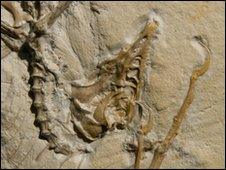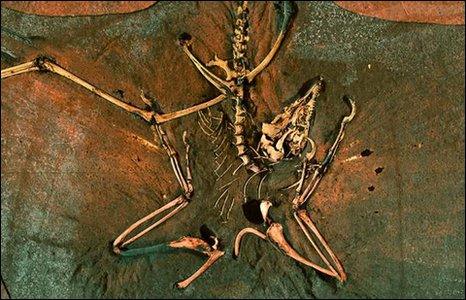Fossil reveals early bird plumage
- Published

Archaeopteryx fossils capture a snapshot of evolution
A new study of a 150-million-year-old fossil of an Archaeopteryx has shown that remnants of its feathers have been preserved.
Archaeopteryx is regarded as a "missing link" that documents a fabulous transition from dinosaur to bird.
The researchers say that it may soon be possible to work out the colours of feathers sported by these creatures.
The new work is published in the journal Proceedings of the National Academy of Sciences (PNAS).
But the authors warn museum curators not to be overzealous in cleaning up fossils for display in case they destroy vital scientific data.
Archaeopteryx is the most iconic of fossils: Many of the specimens beautifully capture this snapshot of evolution - showing the creature's skeleton, feathers and teeth in great detail.
But now a new scanning technique has revealed that one fossil contains fragments of the original feathers - rather than just being an imprint of an animal whose remains had long ago disintegrated into the dust.
The bad news though is that museum curators have inadvertently chipped and scrubbed off a lot more fragments of the creature's feathers and skin fragments as they prepared the fossil for public display to highlight the bones.
But researchers are hopeful they'll be able to study other specimens and obtain more details of the chemistry of the creature's feathers and possibly learn more about their colour.
Dr Roy Wogelius, from University of Manchester, who was among those who made the discovery, is keen to alert curators that the new scanning techniques reveal that many precious fossils contain more than just the remnants of bone.
"One of the things we are very concerned about is that some of the original information has been lost forever," he said.

One fossil contains fragments of the original feathers
"The preparation and curation of (fossils) needs to take account of the fact that there may be very, very small quantities of chemical remains which curators can tend to remove."
The details were obtained by firing intense X-rays at the sample generated by a so-called synchrotron radiation source at the Stanford Linear Accelerator in California, US.
Dr Uwe Bergmann, who led the X-ray scanning experiment at SLAC, said: "People have never used a technique this sensitive on Archaeopteryx before.
"Because the beam is so bright, we were able to see the teeniest chemical traces that nobody thought were there."
Another member of the team, Dr Phil Manning, from Manchester University, believes that the study shows there's now a new way to study long-extinct creatures.
"I wouldn't be surprised if future excavations look more like CSI investigations where people look for clues at a scene of a crime," he said.
In the bones
As well as identifying the feathers the research team also found that the creature's bones have a chemical composition similar to those of birds living today.
"To me that's quite exciting," said Dr Wogelius. "It establishes a nutrient link between Archaeopteryx and modern birds. If you have a pet bird such as a budgie or a paraquet the key nutrients to get right for your pet's health are copper and zinc."
The researchers have learned all they can from this particular specimen. But they hope that their work shows there's more to be learned from fossils and that museum curators should now approach the process of preparing fossils for display with this in mind.
"We've shown that this kind of approach can resolve chemical information that no one has ever seen," according to Dr Wogelius.
"It's an extremely important result for looking at other fossils and it means that there's a lot more richness in chemical detail that in the past has been missed."